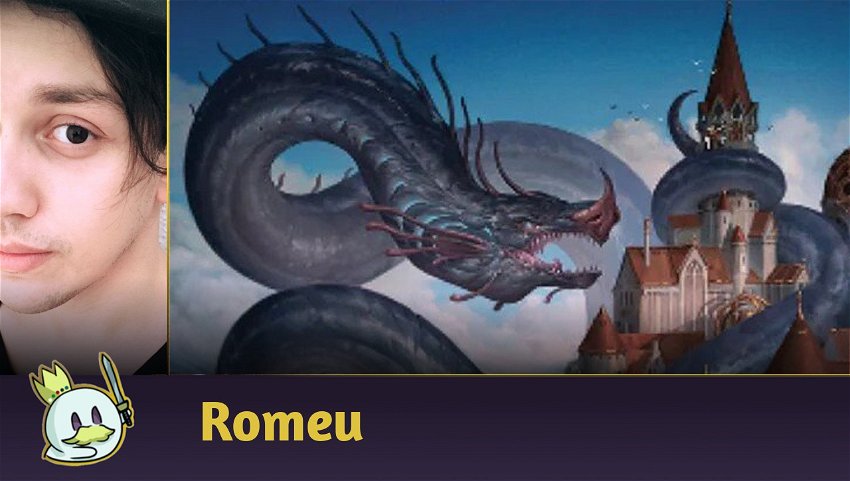With Initiative banned last Monday, Pauper has returned to its normal Metagame stage before the release of Dominaria United — which means it's a good time for us to assess what available options from the new set have already created or can establish some practical impact on the competitive landscape.
Among the cards in the new set, one definitely stands out:

Tolarian Terror is a major threat on its own that can be cast for up to one mana, and that protects itself with little to no difficulty — we might even consider it the Murktide Regent we have at home.
Players have been experimenting with new strategies with this creature since week one, and Dimir Terror is currently the most efficient way to take advantage of it, so let's delve deeper into the archetype and its space in Pauper today.
The Decklist
First, let's go to the decklist I've been running since the last bans.
As you can see, this is a Tempo deck similar to the classic Dimir Delver — low-cost creatures with a fast clock, cheap or free disruption, card selection and counterspells with a small number of lands — and your objective is to delay the opponent's plans and keep the board clean for enough turns to win the game.
Maindeck

These are your threats, with only four copies of each, due to the absence of better options — and even them are relatively contradictory to each other.
Tolarian Terror wants a graveyard full of Instants and Sorceries to cast a high number of them for the lowest mana cost. It protects itself relatively well in a format so geared towards mana efficiency these days, and offers a four-turn clock on an empty board.
Gurmag Angler, on the other hand, wants your graveyard full as soon as possible to feed on it directly, being counterintuitive with Tolarian Terror, and it is necessary to measure how much you need that certain number of Instants and Sorceries in your graveyard before casting it for the lowest cost benefit — However, it is still a 5/5 for up to one mana, allowing you to cast it while maintaining resources for a counterspell or removal.

Our cantrip package is made up of sixteen spells: Brainstorm becomes infinitely more useful than Preordain or Ponder due to its interaction with other spells, allowing for a setup where you can get rid of useless cards from your hand.
Thought Scour is the main "combo" with Brainstorm, and helps to significantly speed up the cast of Tolarian Terror or Gurmag Angler when adding three cards to your graveyard.
Some people have been turning to Mental Note as Thought Scour 5 through 8 — and this is possibly a more consistent approach as it allows us to speed up our creatures, but I don't like giving too many chances to the bad luck of milling my few threats on the list. So Consider has been my cantrip of choice as it still allows me to remove a useless card from the top while positively interacting with Brainstorm and Deep Analysis
Speaking of which, Deep Analysis is the only 2-for-1 feature in our cantrips, offering card advantage for a low cost on early-game and up to four extra draws if the match goes on. Its only drawback is that, against Burn and other aggressive strategies, we can't always afford to lose 3 life to draw two cards.

Our removals include the same ones ran by Dimir Faeries: Snuff Out is much more important here as it is usable for free, allowing us to be more proactive or protect our creatures while dealing with a problem on the opponent's board.
Cast Down deals with basically anything that doesn't have protection or Hexproof in Pauper, being the best two mana black removal in the current Metagame.

Counterspell is the classic must-have answer for any Blue-Based in Pauper, and you should hardly resort to fewer than four of them in your maindeck.
A highlight of my list, however, is the total of four copies of Spell Pierce in the Maindeck, this might look crazy as it loses utility as the game goes on. However, Pauper today is a mana-intensive format: players want to tap out at early-game to play artifacts, want to spend tons of mana later on to cast bombs, or need to perform a sequence of specific spells to win the game and, on all these occasions, Spell Pierce is a solid answer.
Also, along with Tolarian Terror, any removal on that creature alongside Spell Pierce now costs 4 more mana — a steep price to pay in the current format, making it commonly as effective as Dispel or Negate in protecting your threat, while significantly disrupting several strategies' early game plan, such as against Bogles, Boros Synthesizer, Affinity, Burn, Mono Red Blitz, etc.

I also have a number of one-ofs for specific occasions: Dispel is a good safety valve in later stages of a game, Chainer's Edict is a decent extra removal that deals with Hexproof and /or protection while offering a 2-for-1 at the late-game, and Suffocating Fumes is a useful response against go-wide archetypes that is never a useless card due to Cycling.

Our manabase is what you would expect from a Tempo deck: 4 fetchlands for accelerating Gurmag Angler, 4 Ice Tunnel for Manafixing, and a total of 18 lands to ensure you have enough to cast your spells without making your topdeck worse when they are no longer needed.
Sideboard
To explain my Sideboard choices, I'll try to separate them into categories, as there are a relatively high number of one-ofs.

The extra removals package has one more Chainer's Edict to deal with Bogles and as an extra resource against Midranges. I could add a copy of Diabolic Edict in addition to it, but between the Spell Pierce on maindeck and Duress on Sideboard, I think we have enough to prevent any opponent threat from getting too big.
Agony Warp is here for the simple purpose of dealing with Guardian of the Guildpact in a situation where the opponent's board is full, like against Caw-Gate, or other Basilisk Gate decks. It is also decent against basically any other Aggro or Midrange in the current Metagame.
Suffocating Fumes is an extra answer against tokens, Faeries and Elves. Arms of Hadar extends the sweepers' reach and is therefore also useful against Stompy, Moggwarts, and White Weenie.

The anti-interaction package includes an extra copy of Dispel to respond to counterspells and removals in Game 2 against Blue-Based Tempo, where games tend to drag on.
Duress is an efficient way to disrupt early-game plans for Affinity or any archetype that requires a specific setup in the first few turns, while also providing information on whether it's a good time to play a Gurmag Angler, for example.

The anti-red package includes four copies of Hydroblast as a universal answer which is also occasionally useful against Izzet Faeries, Affinity or Jund Cascade, as well as Unexpected Fangs to turn the tide and permanently delay the opposing clock against Aggro decks.

Finally, Nihil Spellbomb feels like a necessary answer to the Mirror Match while also punishing strategies like Boros Bully, Familiars, and Cycling Storm. It's our Sideboard's most linear answer, but it feels like a necessary evil at the moment.
Alternate Card Choices

Delver of Secrets became a bad card in Pauper due to Power Creep. For you to take advantage of it in the format today, you need a specific condition where games become non-interactive and archetypes with numerous flying threats like Faeries and Boros Bully/Synthesizer are declining — This could be the case during the brief weeks when Turbo Initiative was breaking the Metagame, but it definitely doesn't seem like where the format will be now.
Augur of Bolas is an excellent blocker that also interacts with Brainstorm and grants a new spell in your hand. However, not only do we already have sixteen spells that grant us new cards — so its inclusion seems redundant — it also has the terrible drawback of pushing our few winconditions to the bottom. It can be useful in case the Metagame is back to attrition, and we need more creatures to dodge Chainer's Edict and the like.
Finally, Thorn of the Black Rose is excellent in a grindy format and gives us a good card advantage if we manage to keep the crown. However, with so many fast archetypes and/or decks which fills the board with small flying threats in the first turns, it seems like a bad idea to tap out to end up giving a value engine to your opponent.

There are players turning to Mental Note and Dark Ritual to play a Turbo version of the archetype, where you cast Tolarian Terror or Gurmag Angler as early as turn 2.
While I find this proposal interesting, I don't think either of them is in a position to "win the game on their own if cast as early as possible" as was the case with Initiative, so for now, I don't recommend running Dark Ritual — a dead card at all other times — just for that purpose.
Mental Note is a nice option, but as I mentioned earlier, I don't like the idea of taking the risk of milling my few threats — so today I prefer to play it safe and bet on Consider.
Mulligan and Postures
Mulligan

Naturally, Dimir Terror is a Turbo Xerox archetype — which means it's easier to find what you need as you play through its cantrips. Therefore, a hand with a decent number of them, two lands and any means of interaction and/or threats are enough to guarantee a keep against unknown opponents.
Many of the keeps from decks like this, however, have a high risk, high reward factor: if you get the right interaction choice against an unknown opponent in your starting hand, you're off to a good start. But if, for example, you're full of Snuff Out against a Burn, or a Spell Pierce against a creature-based list, you're in trouble and need to find the ideal answer with your cantrips, which might delay your development while advancing the opponent's if not done efficiently.
Things change a lot when you already know what your opponent is piloting, like in Game 2 — you must consider whether the interactions in your hand will be enough to hold the game to the point where your cantrips find more answers and more threats.
This varies a lot from one game to another, and if you are either on the play and on the draw, then there is no general tip on how you should approach your keeps in this case. Just remember that casting cantrips in the early game costs mana and/or a precious resource from your hand that can be better used to get what's needed in grindy matchups or delay your plan too much against aggressive strategies, so relying exclusively on them to find the initial interaction tends to be a bad idea, especially without Preordain.
Posture
Tempo decks are naturally malleable in terms of the posture you adopt in each game and at each moment — they don't play a linear role that tells you exactly how you need to act.
For each game, you need to keep in mind and reconsider whether that is the time to be more aggressive, or to adopt a more reactive line and conserve resources, and so on.
In general logic, you don't want to give the Midranges too much time to grow as they will have more answers and a superior board position than yours in the long run, while also not rushing too fast against very explosive Aggros as their clock will be faster than yours.
In value-oriented games, you prefer to act first and respond later: protecting your threats is key, and preventing that card advantage engine from hitting the board is a must.
On aggressive games, you need to slow their clock down for the first few turns to give yourself enough time to stabilize and punish them for not keeping up. However, there are some exceptions, like against Bogles where an Armadillo Cloak can turn the game around, and therefore you must be a bit faster.
Experience will make a huge difference in understanding what the ideal posture is for each game. So train with the archetype before entering a League or a Challenge.
Sideboard Guide
Mono Red Blitz
IN:

OUT:

Oddly enough, you still want a few copies of Snuff Out against Mono-Red Blitz to ensure an efficient trade if they have more than one threat on the board per turn — taking 4 damage to kill a creature is better than leave a 4/3 or greater alive on the battlefield.
The key to having a positive matchup against Mono Red Blitz is to avoid a hand that has too much redundancy in draws or counterspells, but too few removals — you need to deal with their board since the main focus of your game plan here is to avoid taking lethal damage on a single turn.
Spell Pierce is the only reactive spell worth keeping because normally, it will be the answer to a pump that would kill you on the way back, or a Lightning Bolt to the face for lethal damage.
Bogles
IN:

OUT:

Bogles is a relatively good game in Game 1 if you don't end up keeping the wrong part with targeted removals. Spell Pierce is essential to prevent their game development, and our threats tend to be bigger if they can't get many enchantments in play. Therefore, your counterspells' primary targets should be Ethereal Armor, Armadillo Cloak and Ancestral Mask.
Post-Sideboard the game becomes even more positive because, in addition to an extra copy of removal, we have sweepers to remove smaller creatures, Duress to deal with problematic auras, and Unexpected Fang allows us to beat them at a race.
Affinity
IN:

OUT:

NOTE: I'm still evaluating how much it's really worth removing Counterspell on both play and draw, rather than switching between it and Spell Pierce depending on who goes first, as Spell Pierce becomes useless if the game drags on for too long. It is also possible that Spell Pierce should be replaced by Hydroblast in Games 2 and 3.
The game against Affinity is hard to describe: it depends on what comes first from the other side (setup and card advantage or threats) and what answers you have available (removals or counterspells). If your answers fit well with your opponent's initial proposition, you'll likely have a good start and the upper hand when you start deploying your creatures.
However, Affinity is a value bomb these days, and a pretty difficult one to respond properly to everything it does. Be patient and know how to interpret the possible outs they may have against your threats and/or spells.
Boros Bully
IN:

OUT:

Boros Bully is a tricky game in Game 1 since they have countless chump blocks, and you only have one sweeper on the maindeck. So, your best bet is to preven spells that put too many creatures into play, like Battle Screech, from resolving while trying to pressure them with Gurmag Angler and Tolarian Terror.
Post-Sideboard, Snuff Out and Chainer's Edict are of little use when there is a redundancy in the power of their creatures, and it's not usually worth paying four life to kill Basilisk Gate's target.
Arms of Hadar and Suffocating Fumes are our best cards in this game. Keep them for the right moment, as Nihil Spellbomb should be used with the right timing to avoid making room for them to cast Battle Screech and/or Prismatic Strands on a crucial turn. Unexpected Fangs helps slow their clock, and Agony Warp helps deal with their main threat alongside Basilisk Gate — Guardian of the Guildpact.
The posture doesn't change that much, but the game becomes more malleable. Just remember to be careful with Pyroblast when casting Tolarian Terror.
Izzet Faeries
IN:

OUT:

Like Boros Bully, Izzet Faeries has an easy time producing chump blockers, and is even accompanied by Counterspell and a cheap removal, Skred, capable of dealing with our threats easily — so we're not facing an easy matchup.
Faeries can and will generate more value than you in the long run, so your best route in this game is to try and play for Tempo, casting a quick threat and protecting it while dealing with the opponent's creatures and/or forcing blocks until their resources are exhausted.
Post-Sideboard, due to the added 2-for-1 effects we gained, dealing with their creatures is easier, but keeping our creatures in play becomes significantly more difficult due to the inclusion of Pyroblast, plus we also need to play around Relic of Progenitus.
Conclusion
That's all for today.
If you like Tempo-oriented strategies, where you use the least amount of mana to play your spells and punish greedy archetypes, Dimir Terror probably suits your needs and is proving to be a worthy competitor in the Pauper Metagame.
As the weeks go by, we'll see how the format develops after the last wave of bans, and if there really is room for this deck category today.
Thanks for reading!














— 评论 0
, 反应 1
成为第一个发表评论的人